Environmental Science Report: Life Cycle and Energy Efficiency
VerifiedAdded on 2023/04/03
|20
|2809
|416
Report
AI Summary
This report is a comprehensive analysis of sustainable systems, focusing on two key areas: Life Cycle Assessment (LCA) and energy efficiency. The first part of the report conducts an LCA of two alternative products, yogurt and soda, using the ISO-recommended methodology. The study examines the environmental impacts of each product throughout its life cycle, from production to disposal, and identifies hot spots. The analysis reveals that yogurt is the more sustainable choice due to its lower environmental impact. The second part of the report analyzes the energy efficiency of an iron box, including a cost-benefit analysis over a three-year period. The report concludes that the iron box is relatively energy-efficient and financially sustainable. The report also emphasizes the importance of environmentally friendly energy sources and the need for regulated manufacturing processes to maintain environmental sustainability. The report uses the Harvard WesternSydU referencing style.

1
SUSTAINABLE SYSTEMS
Name of student:
Name of institution:
Date:
SUSTAINABLE SYSTEMS
Name of student:
Name of institution:
Date:
Paraphrase This Document
Need a fresh take? Get an instant paraphrase of this document with our AI Paraphraser
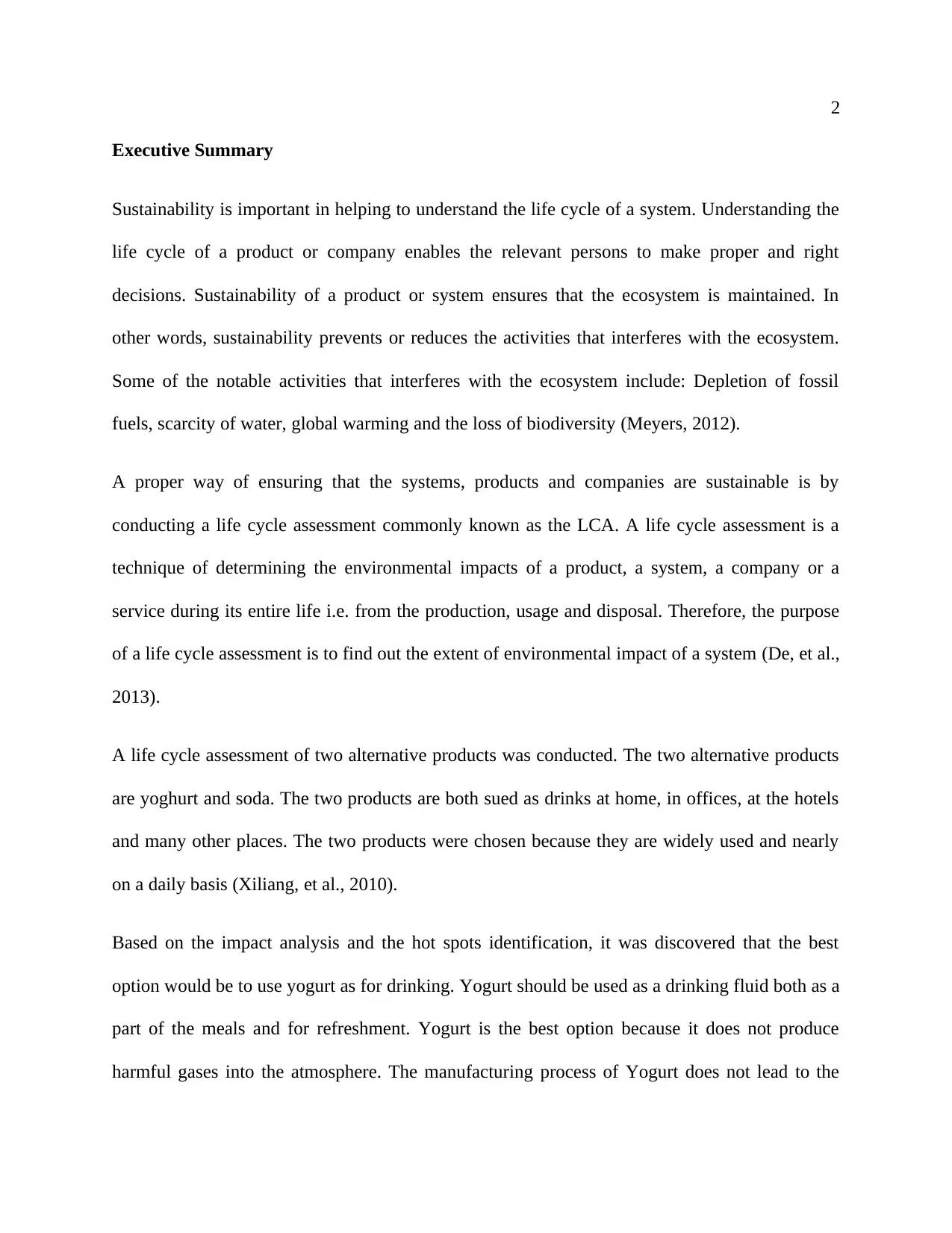
2
Executive Summary
Sustainability is important in helping to understand the life cycle of a system. Understanding the
life cycle of a product or company enables the relevant persons to make proper and right
decisions. Sustainability of a product or system ensures that the ecosystem is maintained. In
other words, sustainability prevents or reduces the activities that interferes with the ecosystem.
Some of the notable activities that interferes with the ecosystem include: Depletion of fossil
fuels, scarcity of water, global warming and the loss of biodiversity (Meyers, 2012).
A proper way of ensuring that the systems, products and companies are sustainable is by
conducting a life cycle assessment commonly known as the LCA. A life cycle assessment is a
technique of determining the environmental impacts of a product, a system, a company or a
service during its entire life i.e. from the production, usage and disposal. Therefore, the purpose
of a life cycle assessment is to find out the extent of environmental impact of a system (De, et al.,
2013).
A life cycle assessment of two alternative products was conducted. The two alternative products
are yoghurt and soda. The two products are both sued as drinks at home, in offices, at the hotels
and many other places. The two products were chosen because they are widely used and nearly
on a daily basis (Xiliang, et al., 2010).
Based on the impact analysis and the hot spots identification, it was discovered that the best
option would be to use yogurt as for drinking. Yogurt should be used as a drinking fluid both as a
part of the meals and for refreshment. Yogurt is the best option because it does not produce
harmful gases into the atmosphere. The manufacturing process of Yogurt does not lead to the
Executive Summary
Sustainability is important in helping to understand the life cycle of a system. Understanding the
life cycle of a product or company enables the relevant persons to make proper and right
decisions. Sustainability of a product or system ensures that the ecosystem is maintained. In
other words, sustainability prevents or reduces the activities that interferes with the ecosystem.
Some of the notable activities that interferes with the ecosystem include: Depletion of fossil
fuels, scarcity of water, global warming and the loss of biodiversity (Meyers, 2012).
A proper way of ensuring that the systems, products and companies are sustainable is by
conducting a life cycle assessment commonly known as the LCA. A life cycle assessment is a
technique of determining the environmental impacts of a product, a system, a company or a
service during its entire life i.e. from the production, usage and disposal. Therefore, the purpose
of a life cycle assessment is to find out the extent of environmental impact of a system (De, et al.,
2013).
A life cycle assessment of two alternative products was conducted. The two alternative products
are yoghurt and soda. The two products are both sued as drinks at home, in offices, at the hotels
and many other places. The two products were chosen because they are widely used and nearly
on a daily basis (Xiliang, et al., 2010).
Based on the impact analysis and the hot spots identification, it was discovered that the best
option would be to use yogurt as for drinking. Yogurt should be used as a drinking fluid both as a
part of the meals and for refreshment. Yogurt is the best option because it does not produce
harmful gases into the atmosphere. The manufacturing process of Yogurt does not lead to the
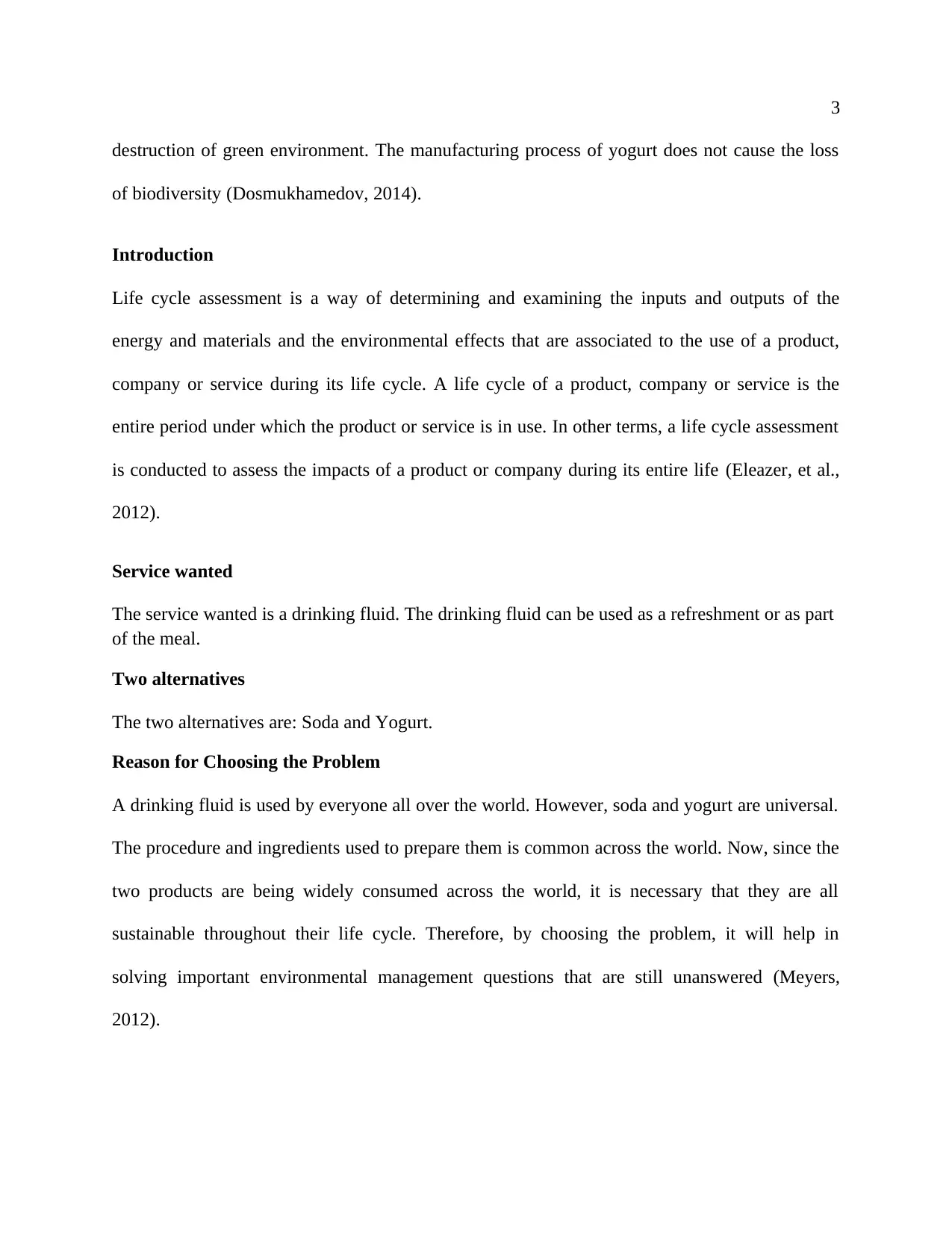
3
destruction of green environment. The manufacturing process of yogurt does not cause the loss
of biodiversity (Dosmukhamedov, 2014).
Introduction
Life cycle assessment is a way of determining and examining the inputs and outputs of the
energy and materials and the environmental effects that are associated to the use of a product,
company or service during its life cycle. A life cycle of a product, company or service is the
entire period under which the product or service is in use. In other terms, a life cycle assessment
is conducted to assess the impacts of a product or company during its entire life (Eleazer, et al.,
2012).
Service wanted
The service wanted is a drinking fluid. The drinking fluid can be used as a refreshment or as part
of the meal.
Two alternatives
The two alternatives are: Soda and Yogurt.
Reason for Choosing the Problem
A drinking fluid is used by everyone all over the world. However, soda and yogurt are universal.
The procedure and ingredients used to prepare them is common across the world. Now, since the
two products are being widely consumed across the world, it is necessary that they are all
sustainable throughout their life cycle. Therefore, by choosing the problem, it will help in
solving important environmental management questions that are still unanswered (Meyers,
2012).
destruction of green environment. The manufacturing process of yogurt does not cause the loss
of biodiversity (Dosmukhamedov, 2014).
Introduction
Life cycle assessment is a way of determining and examining the inputs and outputs of the
energy and materials and the environmental effects that are associated to the use of a product,
company or service during its life cycle. A life cycle of a product, company or service is the
entire period under which the product or service is in use. In other terms, a life cycle assessment
is conducted to assess the impacts of a product or company during its entire life (Eleazer, et al.,
2012).
Service wanted
The service wanted is a drinking fluid. The drinking fluid can be used as a refreshment or as part
of the meal.
Two alternatives
The two alternatives are: Soda and Yogurt.
Reason for Choosing the Problem
A drinking fluid is used by everyone all over the world. However, soda and yogurt are universal.
The procedure and ingredients used to prepare them is common across the world. Now, since the
two products are being widely consumed across the world, it is necessary that they are all
sustainable throughout their life cycle. Therefore, by choosing the problem, it will help in
solving important environmental management questions that are still unanswered (Meyers,
2012).
⊘ This is a preview!⊘
Do you want full access?
Subscribe today to unlock all pages.

Trusted by 1+ million students worldwide
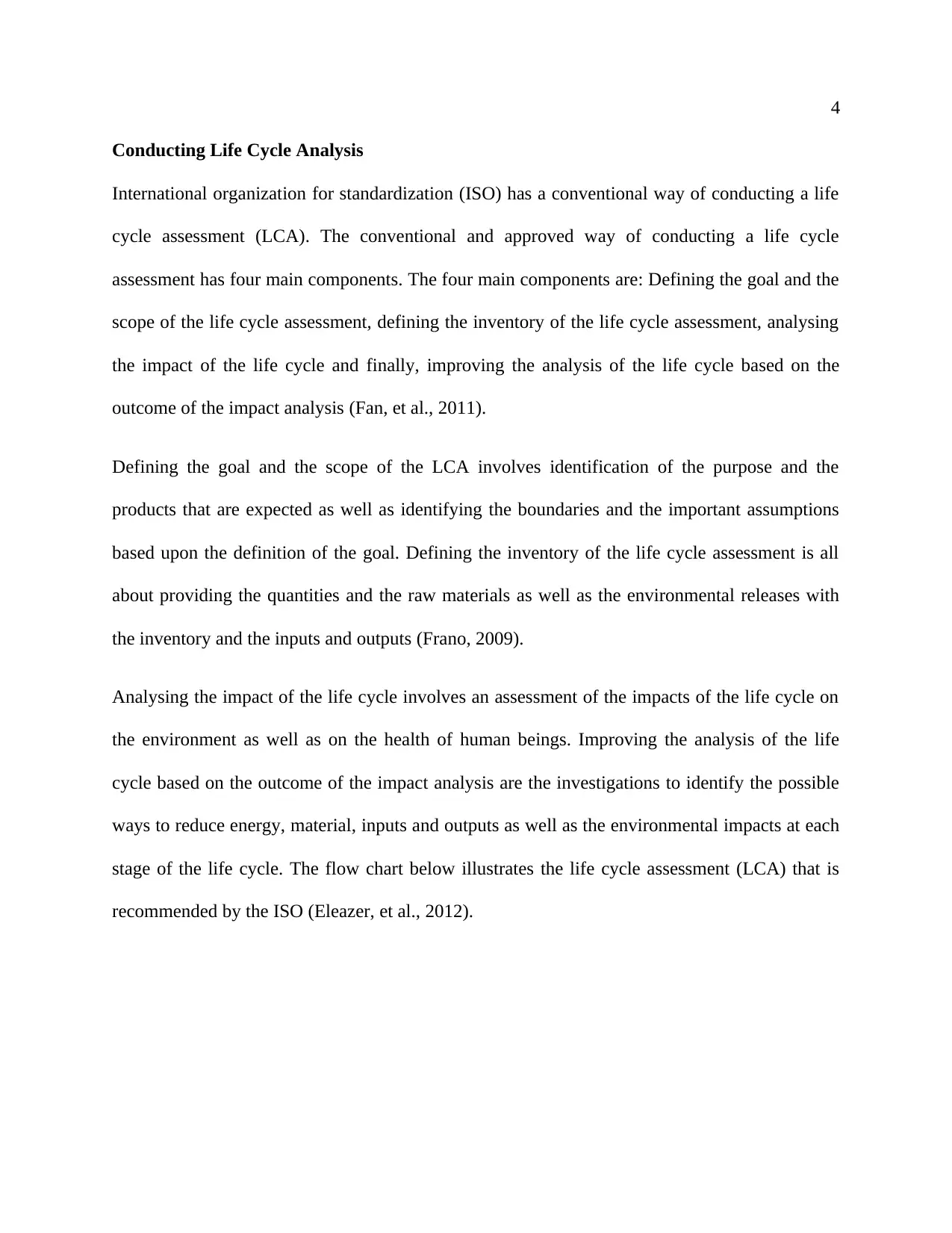
4
Conducting Life Cycle Analysis
International organization for standardization (ISO) has a conventional way of conducting a life
cycle assessment (LCA). The conventional and approved way of conducting a life cycle
assessment has four main components. The four main components are: Defining the goal and the
scope of the life cycle assessment, defining the inventory of the life cycle assessment, analysing
the impact of the life cycle and finally, improving the analysis of the life cycle based on the
outcome of the impact analysis (Fan, et al., 2011).
Defining the goal and the scope of the LCA involves identification of the purpose and the
products that are expected as well as identifying the boundaries and the important assumptions
based upon the definition of the goal. Defining the inventory of the life cycle assessment is all
about providing the quantities and the raw materials as well as the environmental releases with
the inventory and the inputs and outputs (Frano, 2009).
Analysing the impact of the life cycle involves an assessment of the impacts of the life cycle on
the environment as well as on the health of human beings. Improving the analysis of the life
cycle based on the outcome of the impact analysis are the investigations to identify the possible
ways to reduce energy, material, inputs and outputs as well as the environmental impacts at each
stage of the life cycle. The flow chart below illustrates the life cycle assessment (LCA) that is
recommended by the ISO (Eleazer, et al., 2012).
Conducting Life Cycle Analysis
International organization for standardization (ISO) has a conventional way of conducting a life
cycle assessment (LCA). The conventional and approved way of conducting a life cycle
assessment has four main components. The four main components are: Defining the goal and the
scope of the life cycle assessment, defining the inventory of the life cycle assessment, analysing
the impact of the life cycle and finally, improving the analysis of the life cycle based on the
outcome of the impact analysis (Fan, et al., 2011).
Defining the goal and the scope of the LCA involves identification of the purpose and the
products that are expected as well as identifying the boundaries and the important assumptions
based upon the definition of the goal. Defining the inventory of the life cycle assessment is all
about providing the quantities and the raw materials as well as the environmental releases with
the inventory and the inputs and outputs (Frano, 2009).
Analysing the impact of the life cycle involves an assessment of the impacts of the life cycle on
the environment as well as on the health of human beings. Improving the analysis of the life
cycle based on the outcome of the impact analysis are the investigations to identify the possible
ways to reduce energy, material, inputs and outputs as well as the environmental impacts at each
stage of the life cycle. The flow chart below illustrates the life cycle assessment (LCA) that is
recommended by the ISO (Eleazer, et al., 2012).
Paraphrase This Document
Need a fresh take? Get an instant paraphrase of this document with our AI Paraphraser
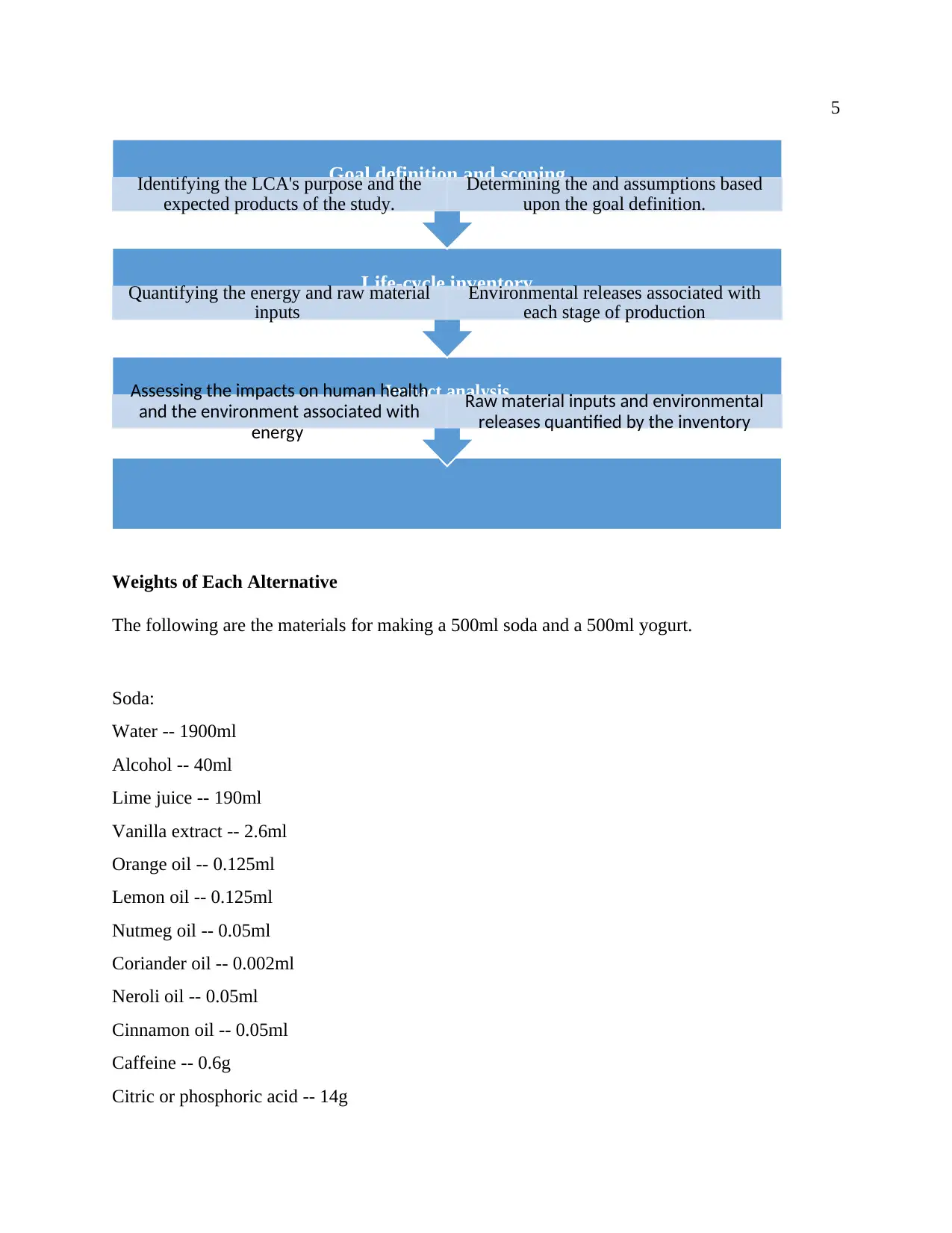
5
Weights of Each Alternative
The following are the materials for making a 500ml soda and a 500ml yogurt.
Soda:
Water -- 1900ml
Alcohol -- 40ml
Lime juice -- 190ml
Vanilla extract -- 2.6ml
Orange oil -- 0.125ml
Lemon oil -- 0.125ml
Nutmeg oil -- 0.05ml
Coriander oil -- 0.002ml
Neroli oil -- 0.05ml
Cinnamon oil -- 0.05ml
Caffeine -- 0.6g
Citric or phosphoric acid -- 14g
Impact analysisAssessing the impacts on human health
and the environment associated with
energy
Raw material inputs and environmental
releases quantified by the inventory
Life-cycle inventoryQuantifying the energy and raw material
inputs
Environmental releases associated with
each stage of production
Goal definition and scopingIdentifying the LCA's purpose and the
expected products of the study.
Determining the and assumptions based
upon the goal definition.
Weights of Each Alternative
The following are the materials for making a 500ml soda and a 500ml yogurt.
Soda:
Water -- 1900ml
Alcohol -- 40ml
Lime juice -- 190ml
Vanilla extract -- 2.6ml
Orange oil -- 0.125ml
Lemon oil -- 0.125ml
Nutmeg oil -- 0.05ml
Coriander oil -- 0.002ml
Neroli oil -- 0.05ml
Cinnamon oil -- 0.05ml
Caffeine -- 0.6g
Citric or phosphoric acid -- 14g
Impact analysisAssessing the impacts on human health
and the environment associated with
energy
Raw material inputs and environmental
releases quantified by the inventory
Life-cycle inventoryQuantifying the energy and raw material
inputs
Environmental releases associated with
each stage of production
Goal definition and scopingIdentifying the LCA's purpose and the
expected products of the study.
Determining the and assumptions based
upon the goal definition.
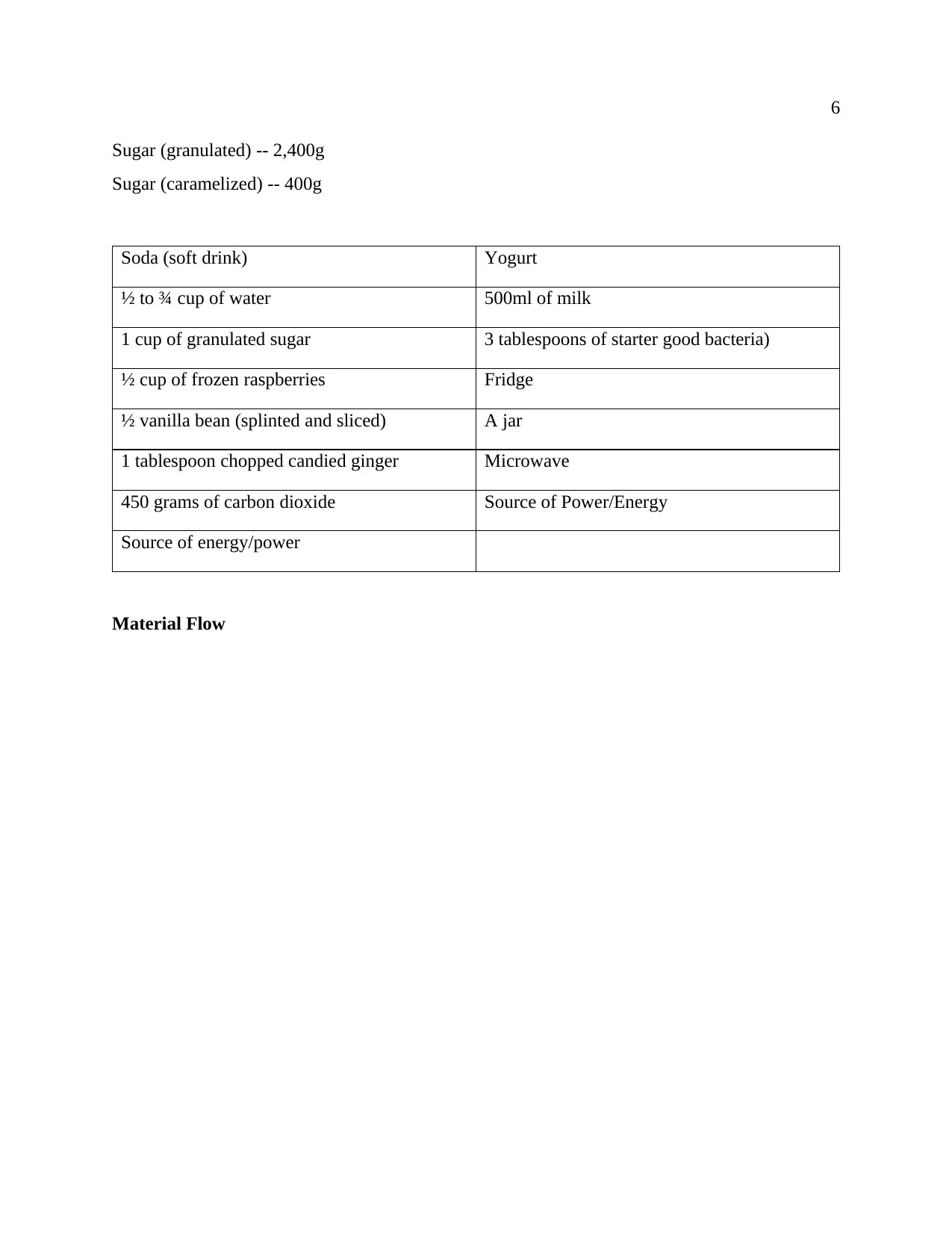
6
Sugar (granulated) -- 2,400g
Sugar (caramelized) -- 400g
Soda (soft drink) Yogurt
½ to ¾ cup of water 500ml of milk
1 cup of granulated sugar 3 tablespoons of starter good bacteria)
½ cup of frozen raspberries Fridge
½ vanilla bean (splinted and sliced) A jar
1 tablespoon chopped candied ginger Microwave
450 grams of carbon dioxide Source of Power/Energy
Source of energy/power
Material Flow
Sugar (granulated) -- 2,400g
Sugar (caramelized) -- 400g
Soda (soft drink) Yogurt
½ to ¾ cup of water 500ml of milk
1 cup of granulated sugar 3 tablespoons of starter good bacteria)
½ cup of frozen raspberries Fridge
½ vanilla bean (splinted and sliced) A jar
1 tablespoon chopped candied ginger Microwave
450 grams of carbon dioxide Source of Power/Energy
Source of energy/power
Material Flow
⊘ This is a preview!⊘
Do you want full access?
Subscribe today to unlock all pages.

Trusted by 1+ million students worldwide
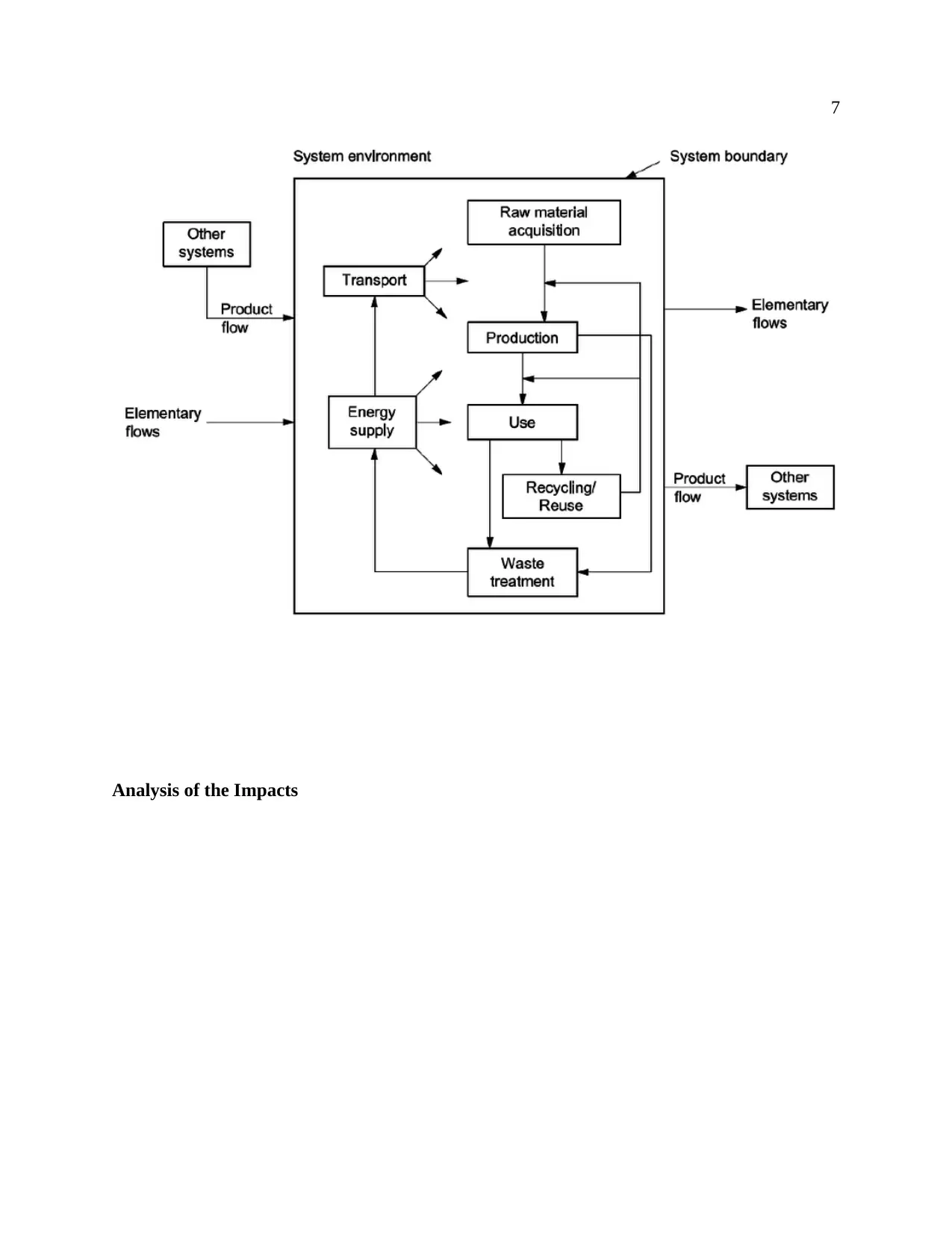
7
Analysis of the Impacts
Analysis of the Impacts
Paraphrase This Document
Need a fresh take? Get an instant paraphrase of this document with our AI Paraphraser
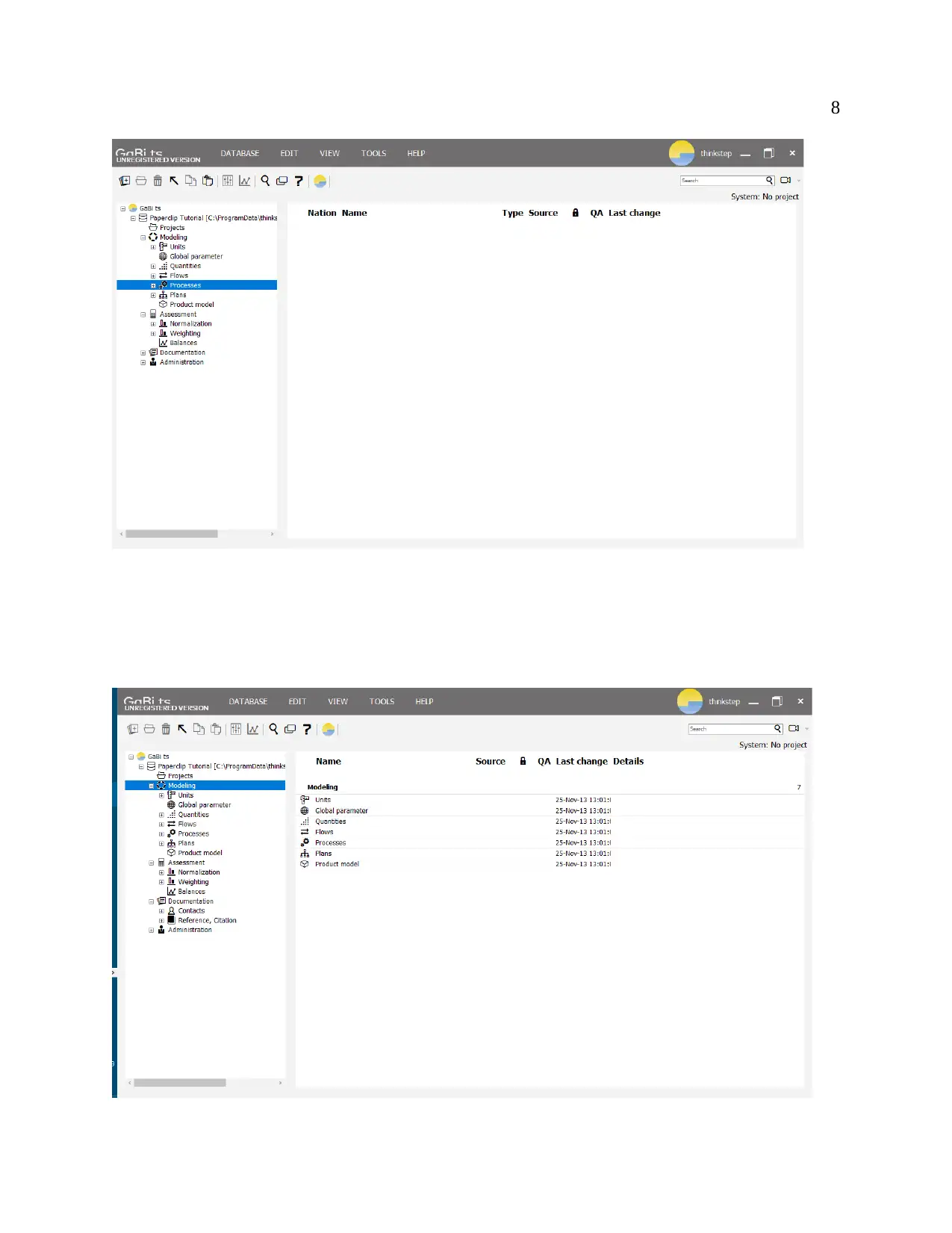
8
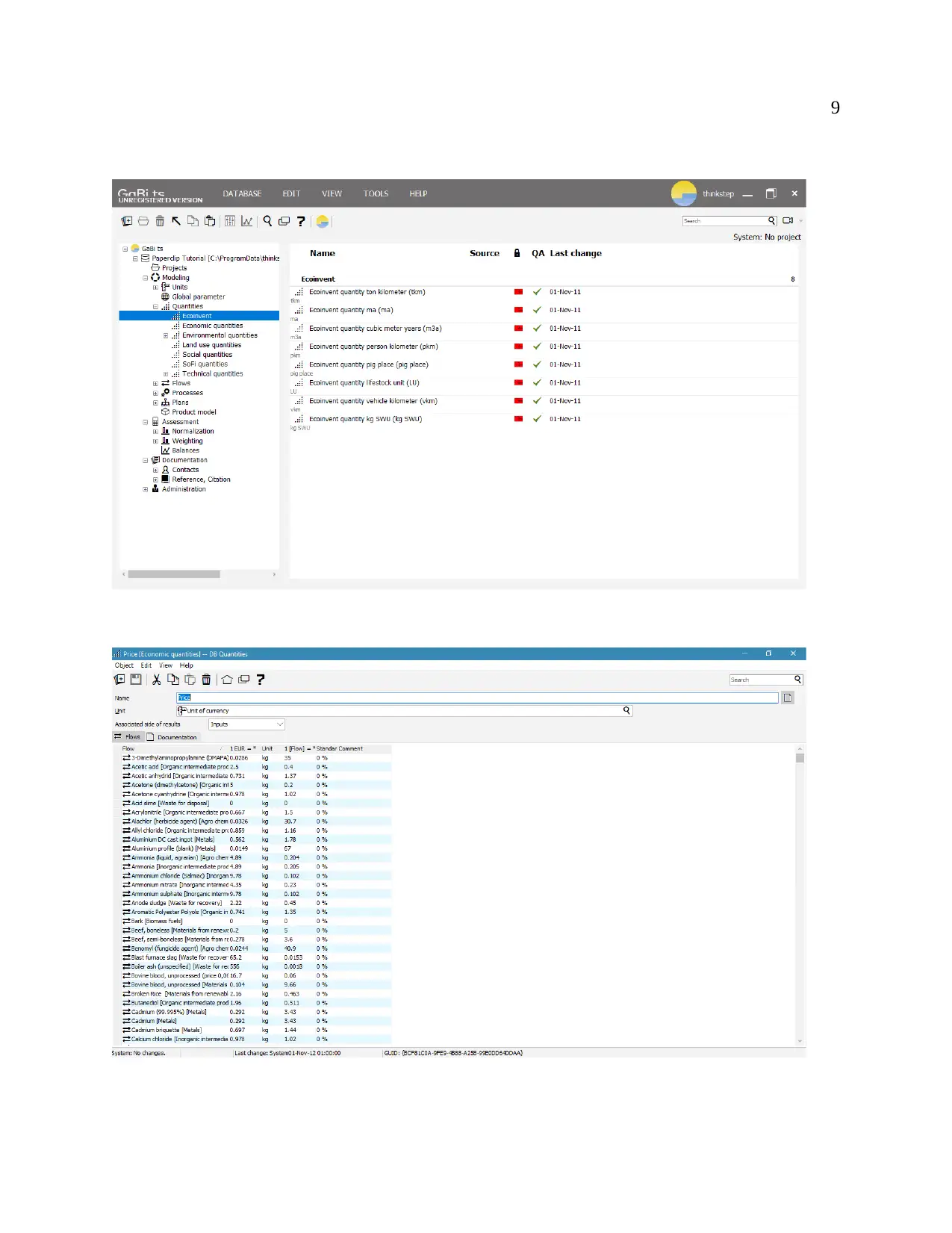
9
⊘ This is a preview!⊘
Do you want full access?
Subscribe today to unlock all pages.

Trusted by 1+ million students worldwide
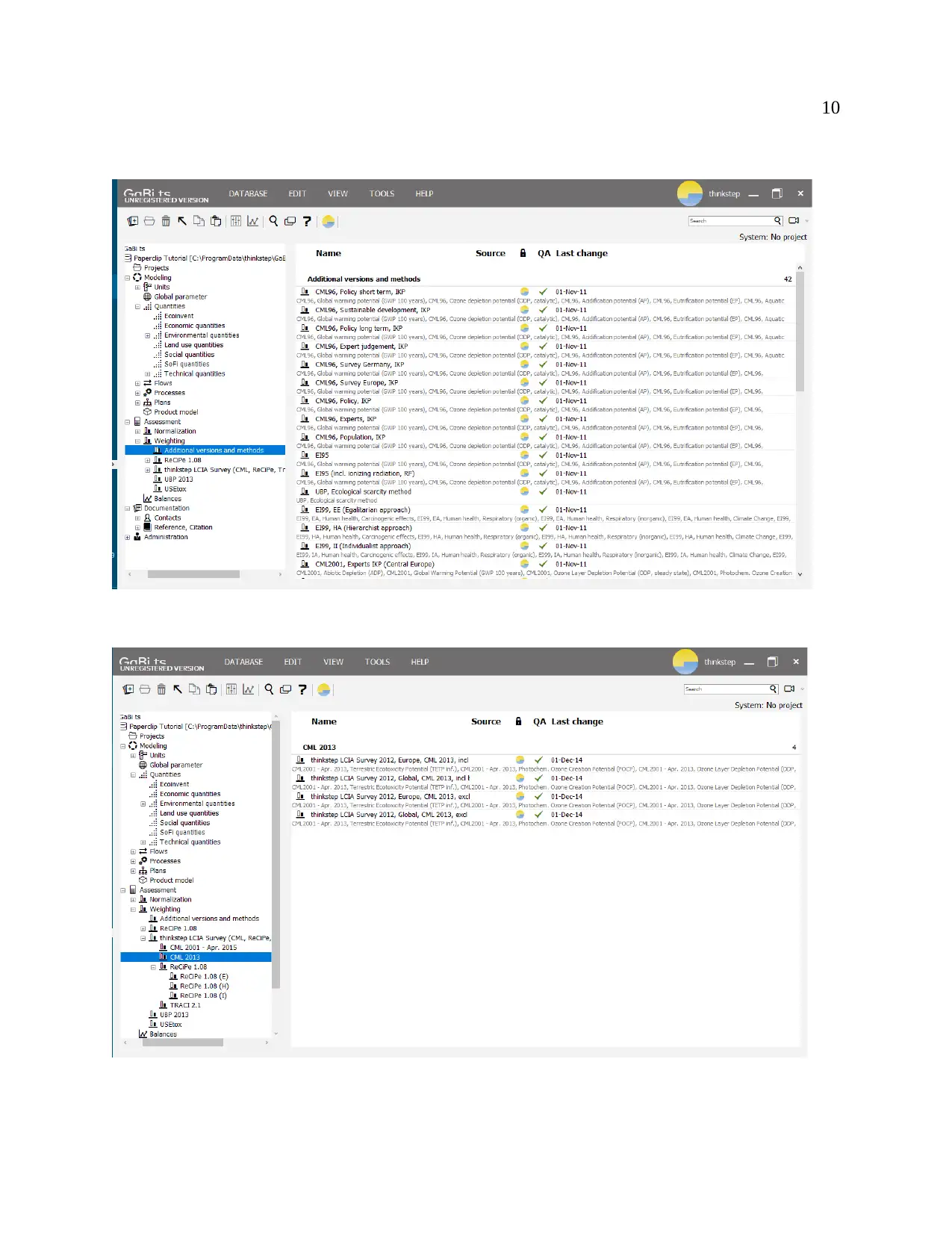
10
Paraphrase This Document
Need a fresh take? Get an instant paraphrase of this document with our AI Paraphraser
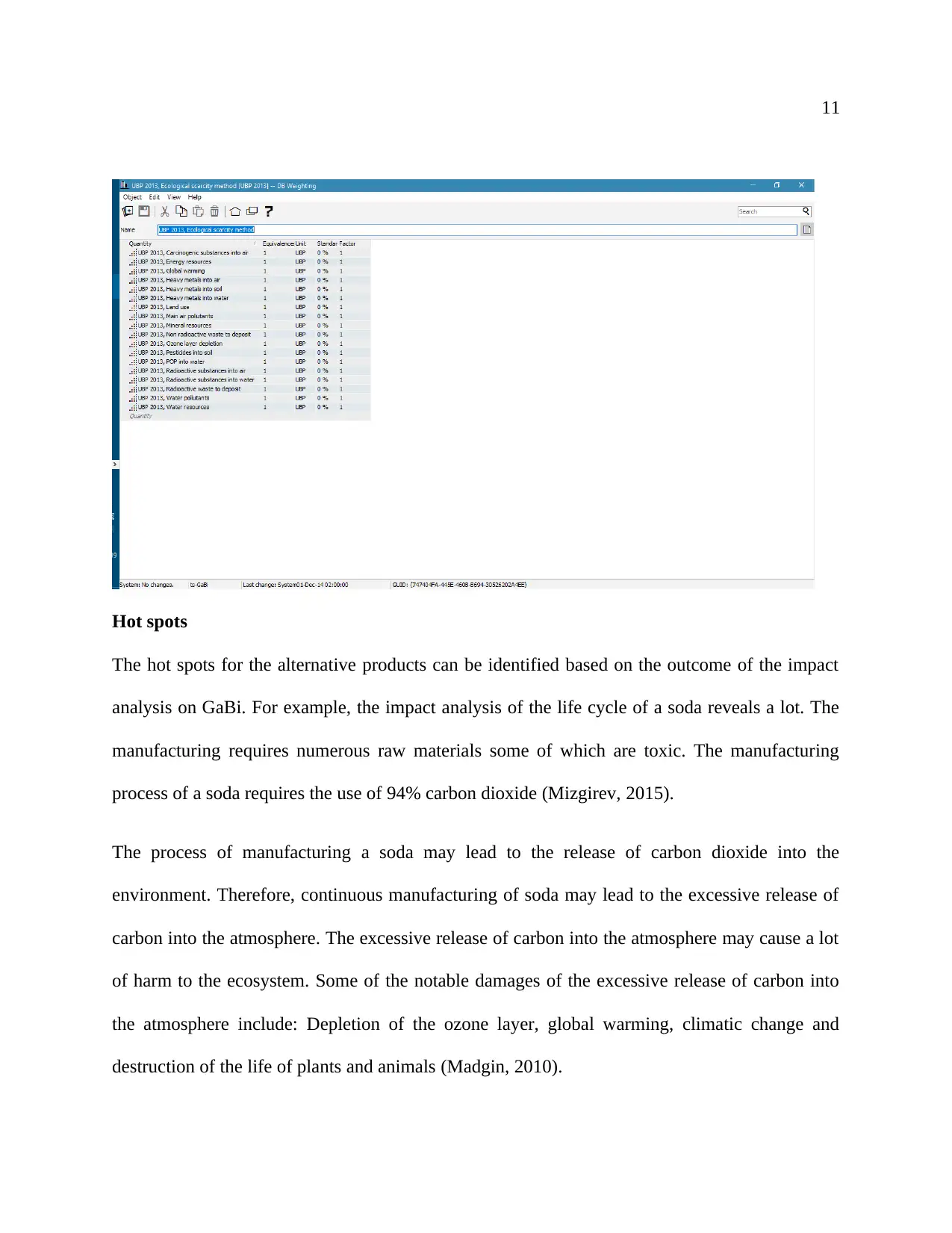
11
Hot spots
The hot spots for the alternative products can be identified based on the outcome of the impact
analysis on GaBi. For example, the impact analysis of the life cycle of a soda reveals a lot. The
manufacturing requires numerous raw materials some of which are toxic. The manufacturing
process of a soda requires the use of 94% carbon dioxide (Mizgirev, 2015).
The process of manufacturing a soda may lead to the release of carbon dioxide into the
environment. Therefore, continuous manufacturing of soda may lead to the excessive release of
carbon into the atmosphere. The excessive release of carbon into the atmosphere may cause a lot
of harm to the ecosystem. Some of the notable damages of the excessive release of carbon into
the atmosphere include: Depletion of the ozone layer, global warming, climatic change and
destruction of the life of plants and animals (Madgin, 2010).
Hot spots
The hot spots for the alternative products can be identified based on the outcome of the impact
analysis on GaBi. For example, the impact analysis of the life cycle of a soda reveals a lot. The
manufacturing requires numerous raw materials some of which are toxic. The manufacturing
process of a soda requires the use of 94% carbon dioxide (Mizgirev, 2015).
The process of manufacturing a soda may lead to the release of carbon dioxide into the
environment. Therefore, continuous manufacturing of soda may lead to the excessive release of
carbon into the atmosphere. The excessive release of carbon into the atmosphere may cause a lot
of harm to the ecosystem. Some of the notable damages of the excessive release of carbon into
the atmosphere include: Depletion of the ozone layer, global warming, climatic change and
destruction of the life of plants and animals (Madgin, 2010).
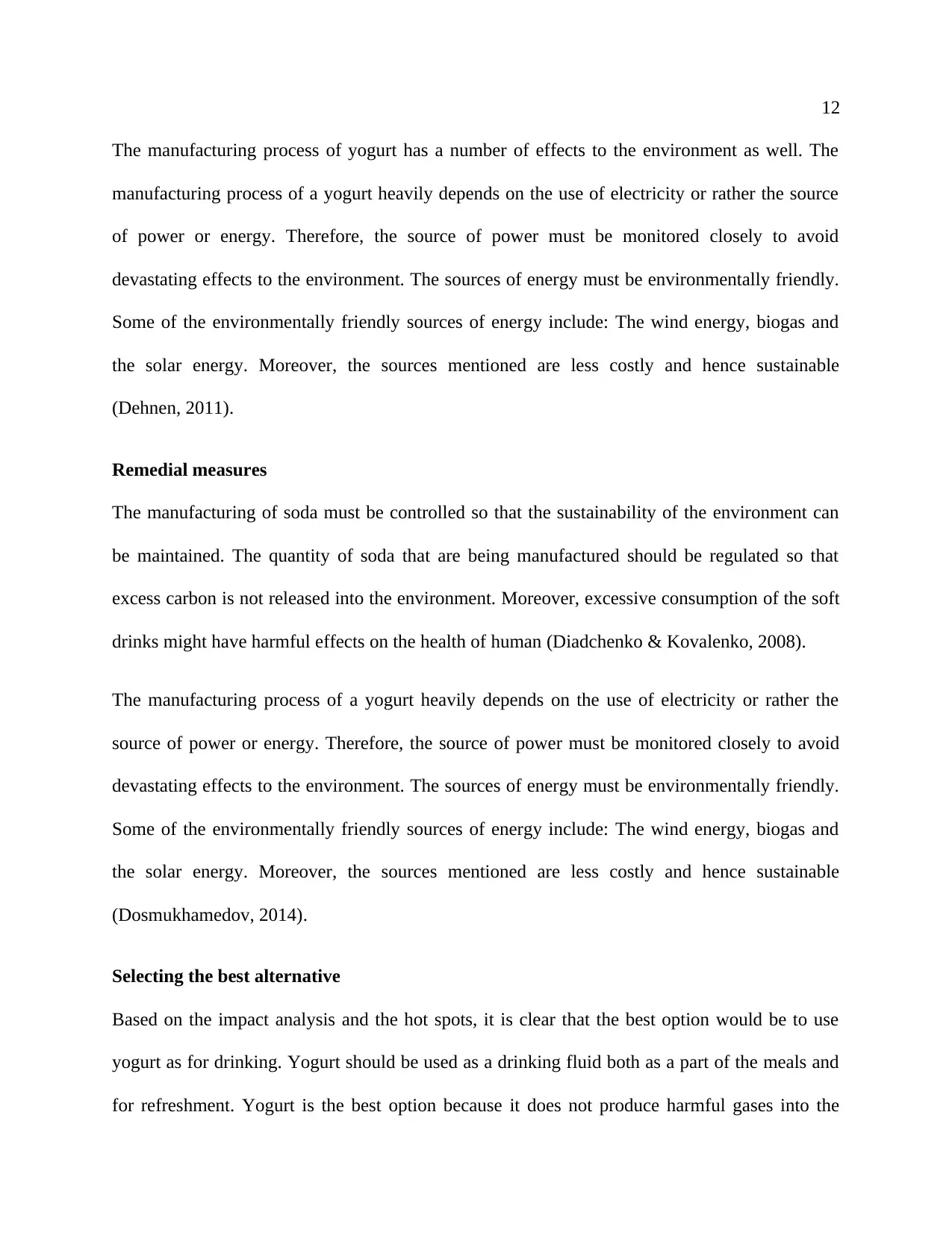
12
The manufacturing process of yogurt has a number of effects to the environment as well. The
manufacturing process of a yogurt heavily depends on the use of electricity or rather the source
of power or energy. Therefore, the source of power must be monitored closely to avoid
devastating effects to the environment. The sources of energy must be environmentally friendly.
Some of the environmentally friendly sources of energy include: The wind energy, biogas and
the solar energy. Moreover, the sources mentioned are less costly and hence sustainable
(Dehnen, 2011).
Remedial measures
The manufacturing of soda must be controlled so that the sustainability of the environment can
be maintained. The quantity of soda that are being manufactured should be regulated so that
excess carbon is not released into the environment. Moreover, excessive consumption of the soft
drinks might have harmful effects on the health of human (Diadchenko & Kovalenko, 2008).
The manufacturing process of a yogurt heavily depends on the use of electricity or rather the
source of power or energy. Therefore, the source of power must be monitored closely to avoid
devastating effects to the environment. The sources of energy must be environmentally friendly.
Some of the environmentally friendly sources of energy include: The wind energy, biogas and
the solar energy. Moreover, the sources mentioned are less costly and hence sustainable
(Dosmukhamedov, 2014).
Selecting the best alternative
Based on the impact analysis and the hot spots, it is clear that the best option would be to use
yogurt as for drinking. Yogurt should be used as a drinking fluid both as a part of the meals and
for refreshment. Yogurt is the best option because it does not produce harmful gases into the
The manufacturing process of yogurt has a number of effects to the environment as well. The
manufacturing process of a yogurt heavily depends on the use of electricity or rather the source
of power or energy. Therefore, the source of power must be monitored closely to avoid
devastating effects to the environment. The sources of energy must be environmentally friendly.
Some of the environmentally friendly sources of energy include: The wind energy, biogas and
the solar energy. Moreover, the sources mentioned are less costly and hence sustainable
(Dehnen, 2011).
Remedial measures
The manufacturing of soda must be controlled so that the sustainability of the environment can
be maintained. The quantity of soda that are being manufactured should be regulated so that
excess carbon is not released into the environment. Moreover, excessive consumption of the soft
drinks might have harmful effects on the health of human (Diadchenko & Kovalenko, 2008).
The manufacturing process of a yogurt heavily depends on the use of electricity or rather the
source of power or energy. Therefore, the source of power must be monitored closely to avoid
devastating effects to the environment. The sources of energy must be environmentally friendly.
Some of the environmentally friendly sources of energy include: The wind energy, biogas and
the solar energy. Moreover, the sources mentioned are less costly and hence sustainable
(Dosmukhamedov, 2014).
Selecting the best alternative
Based on the impact analysis and the hot spots, it is clear that the best option would be to use
yogurt as for drinking. Yogurt should be used as a drinking fluid both as a part of the meals and
for refreshment. Yogurt is the best option because it does not produce harmful gases into the
⊘ This is a preview!⊘
Do you want full access?
Subscribe today to unlock all pages.

Trusted by 1+ million students worldwide
1 out of 20
Related Documents
Your All-in-One AI-Powered Toolkit for Academic Success.
+13062052269
info@desklib.com
Available 24*7 on WhatsApp / Email
![[object Object]](/_next/static/media/star-bottom.7253800d.svg)
Unlock your academic potential
Copyright © 2020–2025 A2Z Services. All Rights Reserved. Developed and managed by ZUCOL.





